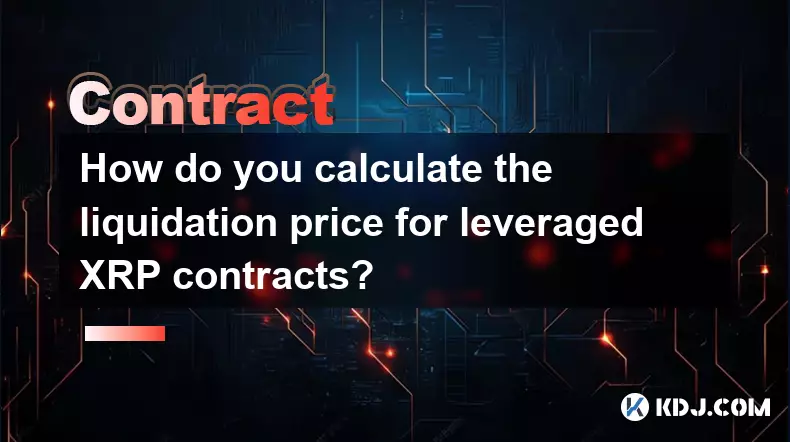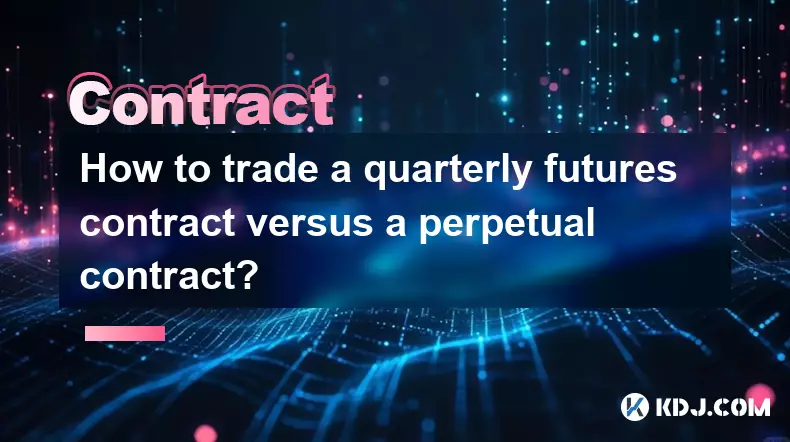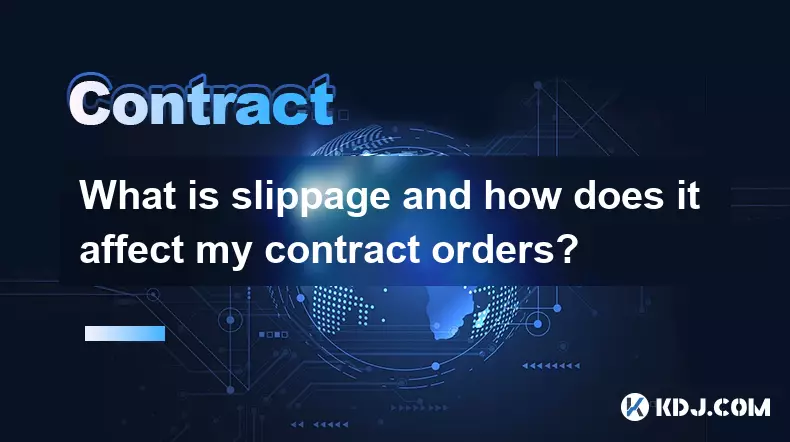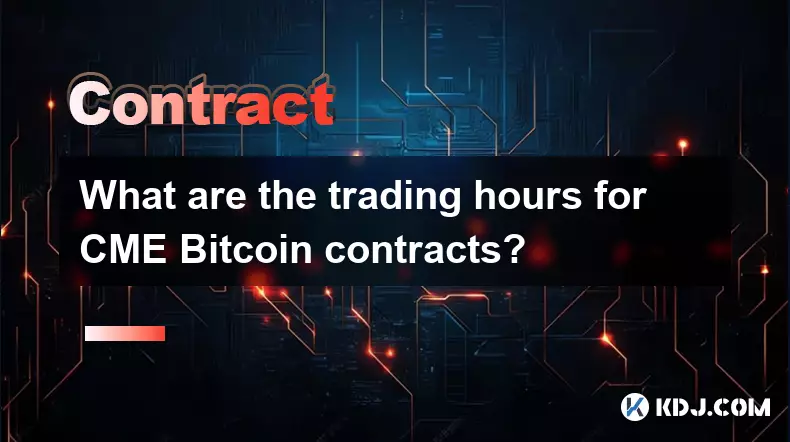-
 bitcoin
bitcoin $100977.009184 USD
-2.05% -
 ethereum
ethereum $3282.009150 USD
-3.23% -
 tether
tether $0.999813 USD
-0.02% -
 xrp
xrp $2.208254 USD
-4.89% -
 bnb
bnb $951.411089 USD
0.55% -
 solana
solana $155.761205 USD
-2.84% -
 usd-coin
usd-coin $1.000217 USD
0.02% -
 tron
tron $0.284475 USD
-1.28% -
 dogecoin
dogecoin $0.162363 USD
-1.53% -
 cardano
cardano $0.533988 USD
-0.47% -
 hyperliquid
hyperliquid $39.174339 USD
-3.22% -
 chainlink
chainlink $14.724828 USD
-1.16% -
 bitcoin-cash
bitcoin-cash $477.297986 USD
-1.28% -
 zcash
zcash $554.227426 USD
17.30% -
 ethena-usde
ethena-usde $0.998995 USD
-0.03%
How do you calculate the liquidation price for leveraged XRP contracts?
The liquidation price for XRP futures depends on entry price, leverage, and margin levels, with higher leverage bringing the liquidation point closer to the entry.
Nov 05, 2025 at 12:00 am

Liquidation Price Mechanics in XRP Futures
1. The liquidation price for leveraged XRP contracts is determined by the initial margin, maintenance margin, and entry price. When trading futures on platforms like Binance or Bybit, traders commit a portion of their capital as collateral. This collateral supports their leveraged position. If the market moves against the trader and the equity in their account drops to the maintenance margin level, the system triggers liquidation.
2. For long positions, the formula typically used is: Liquidation Price = Entry Price × (1 − Initial Margin Rate + Maintenance Margin Rate). For short positions, it becomes: Liquidation Price = Entry Price × (1 + Initial Margin Rate − Maintenance Margin Rate). These calculations assume no funding fees or transaction costs are factored in during rapid price movements.
3. Different exchanges may apply slight variations in their calculation models based on risk engine parameters. Some platforms include accrued funding payments or adjust for insurance fund thresholds. However, the core principle remains consistent—monitoring the ratio between unrealized losses and available margin balance.
4. Traders using 10x leverage on XRP/USDT perpetual contracts will have a narrower buffer compared to those at 5x leverage. A higher leverage amplifies both gains and losses, bringing the liquidation point closer to the entry price. For instance, opening a long at $0.50 with 20x leverage on a platform requiring 0.5% maintenance margin could result in liquidation near $0.475 if adverse price action occurs.
Factors Influencing XRP Liquidation Levels
1. Market volatility directly impacts how quickly a position approaches liquidation. Sudden price swings, especially during high-impact news events or macroeconomic announcements, can trigger cascading liquidations across multiple accounts. This effect is more pronounced in altcoins like XRP due to lower liquidity relative to Bitcoin or Ethereum.
2. Funding rates play an indirect role. In prolonged bullish sentiment, long positions dominate, leading to positive funding rates. While this doesn't alter the liquidation price itself, continuous payments erode available balance over time, reducing the effective buffer before liquidation.
3. Exchange-specific settings such as partial liquidation rules or tiered margin systems affect outcomes. Some platforms reduce position size incrementally rather than closing the entire contract when margin falls below thresholds. This approach aims to preserve trader exposure while managing systemic risk.
4. Slippage during volatile conditions may cause actual execution prices to deviate from theoretical liquidation levels. In fast-moving markets, the mark price—used by most exchanges to prevent manipulation—can diverge significantly from the last traded price, accelerating liquidation triggers.
Risk Management Strategies for Leveraged XRP Trading
1. Setting stop-loss orders below key technical support zones helps avoid reliance solely on automatic liquidation mechanisms. Manual stops allow traders to define exit points based on chart patterns or volume indicators, offering greater control over downside exposure.
2. Monitoring wallet balance and open P&L in real-time enables proactive adjustments. Reducing position size or adding margin before nearing critical levels prevents forced exits. Many experienced traders maintain buffers well above minimum requirements to absorb unexpected volatility.
3. Utilizing lower leverage ratios improves survival rates during consolidation phases. Even with strong directional bias, limiting leverage to 5x or under enhances resilience against whipsaw movements common in XRP’s price action.
4. Diversifying across settlement types—such as quarterly futures versus perpetuals—provides flexibility. Fixed-expiry contracts eliminate ongoing funding obligations, simplifying risk modeling for medium-term outlooks.
Common Questions About XRP Contract Liquidations
What causes discrepancies between mark price and last price during XRP liquidations?Exchanges use mark prices derived from spot indices to prevent price manipulation. During sharp moves, especially on low-volume derivatives markets, the futures price may trade at a premium or discount to the underlying XRP value. This divergence activates liquidations based on fair value rather than tradeable price.
Can I recover funds after my XRP position gets liquidated?Once a position is liquidated, the remaining equity—after deducting losses and fees—is returned to the user's wallet. Most platforms aim to avoid bankrupting traders, so clawbacks beyond deposited margin do not occur. However, the recovered amount may be minimal if the market moved sharply against the position.
How does insurance fund participation affect XRP liquidation outcomes?The insurance fund absorbs losses when positions are closed below zero equity. On certain exchanges, traders whose liquidations contribute to the fund receive rebates. Conversely, excessive liquidation events can deplete reserves, prompting tighter risk controls or temporary suspension of high-leverage tiers.
Do isolated and cross-margin modes impact XRP liquidation pricing differently?Yes. In isolated margin mode, only the allocated collateral is at risk, making liquidation calculations straightforward. Cross-margin uses the entire wallet balance to sustain positions, delaying liquidation until total equity falls below maintenance thresholds. While cross offers more breathing room, it exposes all holdings to potential loss.
Disclaimer:info@kdj.com
The information provided is not trading advice. kdj.com does not assume any responsibility for any investments made based on the information provided in this article. Cryptocurrencies are highly volatile and it is highly recommended that you invest with caution after thorough research!
If you believe that the content used on this website infringes your copyright, please contact us immediately (info@kdj.com) and we will delete it promptly.
- Layer 2 Coins: Will There Be a Potential Explosion by 2026?
- 2025-11-07 16:50:02
- Filecoin, ICP, and the AI Infrastructure Renaissance: Is History Repeating?
- 2025-11-07 16:50:02
- Bitcoin's Wild Ride: Surges, Zeros, and the Search for Stability
- 2025-11-07 17:05:01
- XRP, Bitcoin, and the Rally: What's the Deal, New York?
- 2025-11-07 17:25:01
- Filecoin, DePIN, and a Technical Breakout: What's the Buzz?
- 2025-11-07 17:05:01
- Bitcoin Wobbles: ETF Outflows and the $100K Line in the Sand
- 2025-11-07 18:05:01
Related knowledge

How to trade a quarterly futures contract versus a perpetual contract?
Nov 06,2025 at 06:44am
Understanding the Core Differences Between Quarterly and Perpetual Contracts1. Quarterly futures contracts have a fixed expiration date, typically set...

How to understand the liquidation engine for a crypto contract?
Nov 06,2025 at 09:05am
Understanding the Role of Liquidity Pools in Decentralized Finance1. Liquidity pools are foundational components within decentralized exchanges (DEXs)...

How to use a demo account to practice trading contracts?
Nov 06,2025 at 08:55am
Understanding the Purpose of a Demo Account in Contract Trading1. A demo account allows traders to simulate real market conditions without risking act...

What is slippage and how does it affect my contract orders?
Nov 06,2025 at 05:14am
Understanding Slippage in Cryptocurrency Trading1. Slippage refers to the difference between the expected price of a trade and the actual price at whi...

How to report crypto contract gains on my taxes?
Nov 06,2025 at 06:20pm
Tax Classification of Cryptocurrency Gains1. Cryptocurrency contract gains are typically treated as capital gains in most jurisdictions, including the...

What are the trading hours for CME Bitcoin contracts?
Nov 06,2025 at 02:59pm
Understanding CME Bitcoin Futures Trading Schedule1. The CME Group offers Bitcoin futures contracts that trade nearly around the clock, aligning close...

How to trade a quarterly futures contract versus a perpetual contract?
Nov 06,2025 at 06:44am
Understanding the Core Differences Between Quarterly and Perpetual Contracts1. Quarterly futures contracts have a fixed expiration date, typically set...

How to understand the liquidation engine for a crypto contract?
Nov 06,2025 at 09:05am
Understanding the Role of Liquidity Pools in Decentralized Finance1. Liquidity pools are foundational components within decentralized exchanges (DEXs)...

How to use a demo account to practice trading contracts?
Nov 06,2025 at 08:55am
Understanding the Purpose of a Demo Account in Contract Trading1. A demo account allows traders to simulate real market conditions without risking act...

What is slippage and how does it affect my contract orders?
Nov 06,2025 at 05:14am
Understanding Slippage in Cryptocurrency Trading1. Slippage refers to the difference between the expected price of a trade and the actual price at whi...

How to report crypto contract gains on my taxes?
Nov 06,2025 at 06:20pm
Tax Classification of Cryptocurrency Gains1. Cryptocurrency contract gains are typically treated as capital gains in most jurisdictions, including the...

What are the trading hours for CME Bitcoin contracts?
Nov 06,2025 at 02:59pm
Understanding CME Bitcoin Futures Trading Schedule1. The CME Group offers Bitcoin futures contracts that trade nearly around the clock, aligning close...
See all articles










































































